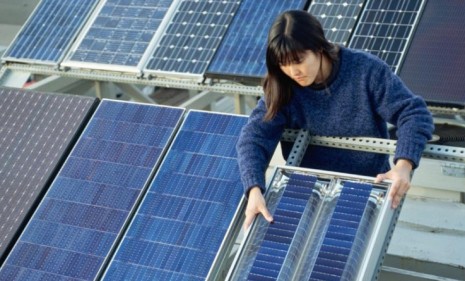Coming soon: Solar cells you can wear?
Forget rigid solar panels. Scientists have created a new photovoltaic carbon flexible enough to be worn

Imagine: Shirts and jackets capable of harvesting solar power. Your iPhone might never run out of juice again (just plug it into your vest). Such scenarios might become reality sooner than you think. Researchers from Northwestern University have created a new type of solar cell capable of bending — and, conceivably, being integrated into fabric. Here's what you should know:
How do traditional solar panels work?
Light enters a transparent cell, and thanks to a complicated process in which the sun's photons travel through a semiconductor, electricity comes out. This photovoltaic cell technology hasn't progressed much since solar cells were invented in the 1880s, according to Dave Collier at Earth Times. That's largely due to a limited supply of the necessary materials (namely, indium tin oxide). "If solar technology really becomes widespread, as everyone hopes it will, we will likely have a crisis in the supply of indium," says Mark C. Hersam, the professor who headed the Northwestern study.
The Week
Escape your echo chamber. Get the facts behind the news, plus analysis from multiple perspectives.

Sign up for The Week's Free Newsletters
From our morning news briefing to a weekly Good News Newsletter, get the best of The Week delivered directly to your inbox.
From our morning news briefing to a weekly Good News Newsletter, get the best of The Week delivered directly to your inbox.
What about these new solar panels?
They use carbon, which the earth has in abundance. Hersam and his colleagues were able to create a viable alternative to indium by stitching together tiny carbon nanotubes. An added benefit: Compared to "mechanically brittle" indium, carbon nanotubes are actually quite flexible, granting the new cells versatility the old solar cells never had.
And I can wear these new solar panels?
Potentially, yes. United Press International says that military personnel could build the technology into tents to power their gear. And for the rest of us, "the cells could be integrated into clothing, backpacks, or purses for wearable electronics."
A free daily email with the biggest news stories of the day – and the best features from TheWeek.com
Sources: Earth Times, Northwestern University, United Press International
-
 The Week Unwrapped: What’s the cost of PFAs?
The Week Unwrapped: What’s the cost of PFAs?Podcast Plus why is George Osborne joining OpenAI? And has universal basic income finally come of age?
-
 The week’s best photos
The week’s best photosIn Pictures A dervish dance off, a frosty forest, and more
-
 Mount Rainier is on its way down
Mount Rainier is on its way downUnder the radar Its peak elevation is approximately 20 feet lower than it once was